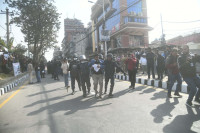Opinion
Not over yet
We are finally seeing the much-delayed Reconstruction Authority come to life three months after the Gorkha earthquake.
Gyanendra Gurung
We are finally seeing the much-delayed Reconstruction Authority come to life three months after the Gorkha earthquake. Hopefully, this new team will push the pedal towards rebuilding our damaged structures as quickly as possible, and retrofitting rural and urban settlements throughout the nation. However, it is very frustrating to see politicians and the public squandering precious time by squabbling over other issues. Have we forgotten about the thousands of lives that were lost? I remember how outraged we were with the lax relief and rescue operations during the crisis and as scientists warn us to brace ourselves for future disasters, shouldn’t we instead be racking our brains to improve the swiftness of such operations? If we are genuinely serious about saving more lives, then we must commit ourselves in making better preparations today, before the next crisis strikes again.
From event to action
Whenever there is a major earthquake in the world, the US Geological Survey (USGS) works meticulously to relay the shock’s magnitude and location to the public as quickly as possible. In addition to this, they also quickly estimate and publish the number of injured people. This information is vital to the government and humanitarian groups, because it allows them to act appropriately in times of a crisis. For the Gorkha earthquake, the USGS had flagged it to be deadly in terms of fatalities. This is where most of the international relief and rescue teams that came to help Nepal got their preliminary information about the disaster.
At home, Nepali youths were already at the forefront of humanitarian efforts. The detailed maps of Kathmandu already created by the local OpenStreetMap community— the Wikipedia of mapping, as it allow users to freely view and edit data (open source)—and Kathmandu Living Labs, rescue and relief groups were able to identify areas that needed help, and the kind of help that they needed. Soon after that, there was a concentrated effort using more than 2,400 volunteer mappers—national and international—who mapped the earthquake devastation using the OpenStreetMap platform. Volunteers were mapping out the accessibility of roads and the conditions of buildings after the earthquake—not only in Kathmandu, but also in the rest of the affected districts—using information from brave volunteer teams working on the ground. This is undoubtedly an application of geospatial knowledge worthy of a special humanitarian award.
Open-source system
Now, the question is: how can we foster this locally developed technology to prepare us for the next big one? The earthquake information published by USGS is usually more holistic and cannot be used to analyse earthquake-affected areas such as individual houses, alleys, and so on. Thus, for local operations, we would need more details about the locality, which the open-source mapping groups are already in possession of. The only missing ingredient now is the science. So, if we are to link this mapping technology with the seismic information from the National Seismological Centre, then we can easily develop an open-source system for the rapid assessment of damages during an earthquake. Quick estimates will allow aid assistance to be coordinated efficiently in times of crisis and more lives can be saved. Moreover, local clubs, voluntary groups, and so on, will also be able to access this free information and identify the locations nearest to them that need immediate assistance as well.
Though such a rapid assessment system can be bundled as part of the Earthquake Early Warning (EEW) system, operating it independently can be cheaper. Moreover, since the usefulness of an expensive EEW system in reducing casualties in our unplanned urban cities is quite low, wouldn’t it be wiser to spend a fraction of that money to build on top of readily-available knowledge and develop a relatively cheaper integrated system of rapid real-time assessment of damages to aid the relief and rescue operations? These young, homegrown organisations have already built an efficient open-source mapping platform linking relief and rescue operations; now all we need to do is connect it with the hard geo-scientific data it needs to become an invaluable tool for crisis management for future disasters.
In a recent article in the International Journal of Disaster Risk Reduction, Abbas Kangi talks about a similar system already in place in Mashhad, Iran. Whenever there is an earthquake, their rapid damage assessment system receives the magnitude and epicentral location from their seismological centre, and then—based on scientific modelling and geotechnical information of the ground—assesses the expected the intensity of the ground shaking within the city. It then rapidly estimates the physical, human, and economic damage.
So, what are we waiting for? The geospatial data is out there and updated, but the geological data—along with other integral scientific and socioeconomic data—is fragmented and out-dated. To begin with, the National Seismological Centre—with its enormous scientific capacity and immense collection of seismic data from the Himalayas—should team up with engineering seismologists, geotechnical engineers, and others to seriously think about updating the seismic hazard maps of each and every human settlement in Nepal. These hazard maps, which tell us how much shaking to expect from an earthquake at certain locations, are just few of the foremost elements that needs to be integrated into the open-source mapping technology for operating a successful rapid damage assessment system.
Fast and reliable internet
The backbone of this system is the internet. Whenever a devastating earthquake occurs, the rapid damage assessment system will—after generating maps and information from the disaster-struck areas—disseminate it quickly through the web, allowing the first responders to act upon the information in real-time as quickly as possible. And since most of our urban areas are connected to the internet, this system can be cheaply replicated as part of the disaster preparedness measures for crowded cities in Nepal. But what about the rural dwellings? Even though the government has promised to install internet services in the earthquake-affected districts in the recent budget speech, we should immediately think about linking up with already-existing wireless network developed by Mahabir Pun’s Nepal Wireless Project. They provide wireless internet to rural and remote locations of the Himalayan region, and if we hook up with their network, then the scientific and social benefits to the Himalayan folks can be manifold. Moreover, we can complement Pun’s objectives by facilitating real-time monitoring of Himalayan hazards, community-based early warning systems, meteorological monitoring, and so on.
We have to act fast and we have to act now. As every inch of our nation lies over hazardous ground, the clock is always ticking and we must always be on our toes. If we can promote open-source technology and link our tech-savvy youths and their expertise with the much-needed hard geo-scientific database, we can not only open up unexplored avenues for affordable, feasible, and innovative scientific initiatives that can not only enhance disaster-preparedness programmes and humanitarian efforts, but also resuscitate the scientific vigour in the younger generations to come.
Gurung is a Post-doctoral Research Fellow at Chonbuk National University, Jeonju, South Korea.




 19.12°C Kathmandu
19.12°C Kathmandu










